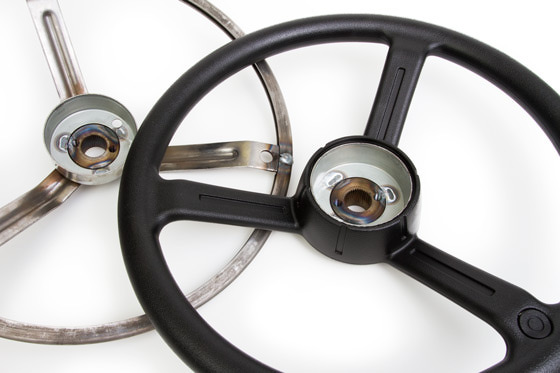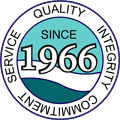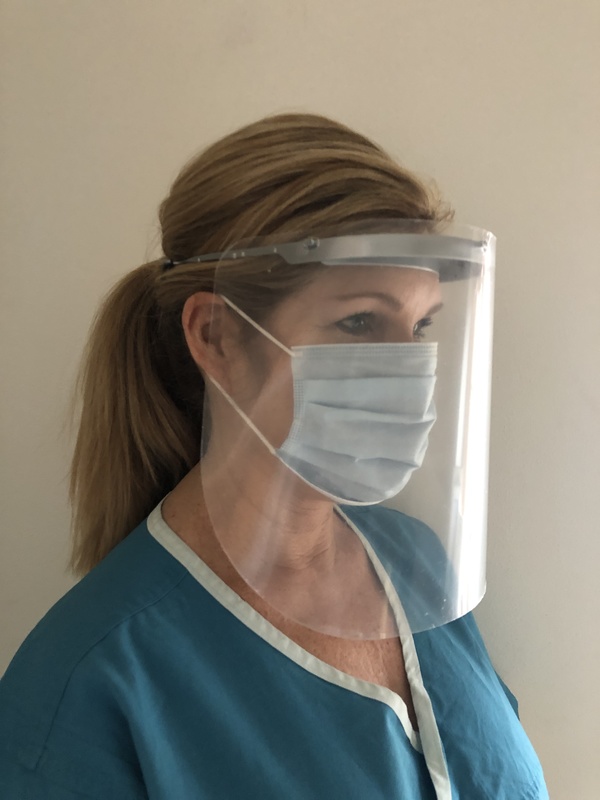Custom Injection Molding
Plastic Parts, Inc. has been developing award-winning products using custom plastic injection molding methods for over 47 years. Our extensive experience and continuous advancement incorporating the latest technology and techniques allows us to create successful products at the highest value for our customers.

Plastic injection molding is the most commonly used manufacturing process for the fabrication of plastic parts because it enables the development of a wide variety of products that can vary greatly in size, complexity, and application. Several types of custom plastic injection molding processes are used to achieve desired product characteristics including scientific molding, insert molding, over-molding, gas assist molding and plating.
Scientific Molding
Scientific molding is a disciplined approach we use to determine and control optimum plastic injection molding process parameters. Scientific molding also produces consistent quality molded plastics at a lower overall cost for a wide range of industry applications.
The scientific injection molding method establishes repeatable plastic injection molding process parameters based on predictable facts and data. It allows us to monitor and control the process to systematically eliminate any variables that would result in defective or low quality parts.
Insert Molding
Plastic injection insert molding is a process that molds thermoplastic material around an insert piece (or pieces) placed into the plastic injection molding cavity. It produces a strongly bonded integrated assembly, with the insert(s) encapsulated by the plastic. Custom plastic insert molding allows for almost unlimited configurations and material combinations. Inserts can be made from a variety of materials so long as the material is able to withstand the plastic injection molding process. These inserts could include metal, brass, ceramic, steel-threaded parts, machined-metal parts, electrical connectors, or plastic substrates.
Insert molding is advantageous when certain areas of plastic parts need greater strength. It can change the function of the part such as conductivity or insulation in a component for electrical use. Machined brass and steel threaded inserts can be used when pull-out strength is needed and custom-stamped steel parts can be inserted where a wall section is too thin for plastic molding. The insertion of machined steel or non-ferrous metals will increase the flexural strength of a plastic part, while conductive metal can be used to confer electrical transmission across a part. Selective plastic placement over metals can confer electrical insulating properties.
Insert molding allows for reduction of part size and weight because parts are joined with strong, light weight plastic resin and fasteners or connectors are eliminated. Insert molding of components ensures proper alignment, prevents loosening and the plastic resin can provide improved resistance to vibration and shock. Another application of the plastic injection insert molding technology is in-mold decorating (IMD) and in-mold labeling (IML).
Thermoplastic Encapsulation / Overmolding
Thermoplastic encapsulation overmolding is a plastic injection molding process in which one thermoplastic material is molded over another material to form one part. Using two separate plastic injection molds on a molding press, two materials are bonded together to form one plastic part with a unique visual appearance or ergonomic form. Dissimilar plastics can form the functional and aesthetic attributes of a product.
Custom thermoplastic encapsulation overmolding is also used to improve component reliability. It provides strength to protect and/or improve a part or end product, while reducing cost, labor and materials. Thermoplastic overmolded components ensure proper alignment, prevent loosening, and the plastic resin can provide improved resistance to vibration and shock. A wide range of thermoplastic materials can be over-molded, including soft plastics such as urethanes and thermoplastic elastomers (TPE), and hard plastics such as nylon and polycarbonate.
Plastic injection insert molding and plastic over-molding are an effective alternative to manufactured aseemblies that use soldering, adhesives or fasteners and provide numerous benefits including:
- Reduces secondary operation and assembly
- Eliminates need for bonding during manufacturing
- Increases heat and overload protection
- Reduces part size and weight
- Improves part strength and structure
- Offers options to differentiate the appearance of parts
Custom plastic overmolding and insert molding applications provide product advantages across a wide range of industries and applications including:
- Stators and small engine parts
- Outdoor power equipment components
- Steering wheel components
- Appliance knobs, controls and assemblies
- Encapsulated electronic devices and electrical components
- Medical devices and instruments
Plastic Parts, Inc. offers expertise in proper mold construction and material selection – critical in maintaining part tolerances and tooling reliability. We often use robotic automation in our plastic over-molding process for quick, precise insert placement. With our many years of custom plastic over-molding experience, we achieve innovative solutions for parts and components that improve the quality, reliability and appearance of the end product while lowering costs for our customers.
Gas Assist Molding
Gas assist injection molded plastics are a great option for reducing time, material and cost without sacrificing quality or design options. During the gas assist molding process, plastic material is melted and injected into mold cavities through the conventional plastic injection molding process. As the material comes in contact with the mold walls it begins to solidify while nitrogen gas is injected into the mold through strategically designed and placed gas channels, providing low pressure that pushes the plastic material into the mold extremities, eliminating sink marks and surface blemishes. Once the plastic cures, the nitrogen is vented and the gas assist injection molded plastic parts are removed from the mold. The need for less plastic material and the consistent pressurization within the mold enables gas assist injection molded plastics to cool faster, reducing cycle times and increasing machine output which saves time and cost for our customers.
Most thermoplastics materials can be used in gas assist injection molding such as ABS (Acrylonitrile Butadiene Styrene), PC (Polycarbonate), HIPS (High Impact Polystyrene), PA (Nylon), PBT (Polybutylene Terephthalate), PET (Polyethylene Terephthalate), PPE (Polyphenylene Ether) and PP (Polypropylene).
Advantages of gas assist molding include:
- Lowers plastic material needed
- Reduces part weight and multiple part assemblies
- Decreases cycle time
- Increases part strength and rigidity
- Reduces warping and distortion
- Improves part appearance
- Reinforces ribbed parts
- Creates greater design options
Applications for gas assist injection molded plastics include:
- Steering wheels
- Medical equipment housings
- Appliance, automotive and lawn mower parts
- Office equipment components
- Long tubular shapes, such as shovel handles
- Large parts with ribs and bosses
Consider gas assist molding where dense sections of plastic are needed. Our in-house team is well-versed at developing proper mold design and mold flow analysis – important for successful gas assist injection molding.
Plated Plastic Parts
Plated plastic parts offer many advantages over metal components. They are considerably more lightweight, flexible and inexpensive to produce. Plated plastic parts also provide corrosion resistance, strength, and chemical resistance. Aesthetic advantages are achievable through a process that offers many finish options to enhance the plastic and provide durable, long-lasting performance. Along with our plating service partners, we provide a range of plated plastic finishes including chrome (satin chrome and black chrome), satin pearl, gold, and black sapphire. Various metallic colors are also available.
To enable the plating to adhere, a special type of electroplating-grade plastic called Acrylonitrile Butadiene Styrene (ABS) is used. It is possible to accommodate other types of plastics in this process.




